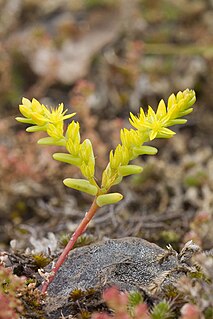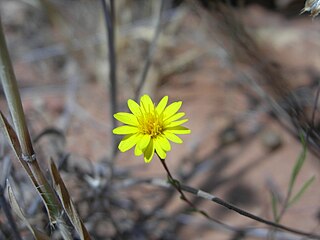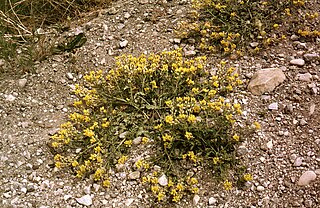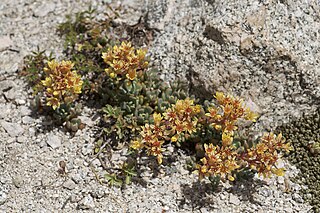
Lasthenia burkei is a rare species of flowering plant in the daisy family known by the common names Burke's goldfields and Burke's baeria.

Allium munzii is a rare species of wild onion known by the common name Munz's onion.

Arctostaphylos pajaroensis is a species of manzanita known by the common name Pajaro manzanita. It is endemic to California, where it is known mainly from Monterey County.

Ceanothus maritimus, with the common name maritime ceanothus, is a species of shrub in the buckthorn family Rhamnaceae. It is endemic to San Luis Obispo County, California, where it is known from only a few occurrences in the vicinity of Hearst Ranch. It shares the same range as the similarly rare Ceanothus hearstiorum, growing on the coastal bluffs.
Cordylanthus orcuttianus is a rare species of flowering plant in the family Orobanchaceae known by the common name Orcutt's bird's beak. It is native to Baja California and southern San Diego County, California, where few populations are known. It is a plant of coastal scrub habitat. This annual herb grows to a maximum of half a meter in height and is green to reddish-green in color and coated in stiff hairs. The leaves are up to 8 centimeters long and dissected into narrow segments. The inflorescence is a very dense cluster of flowers surrounded by bracts which are divided into narrow segments like the leaves. Each flower is up to 2.5 centimeters long and is made up of a yellow-tipped white fibrous pouch enclosed by a calyx of sepals.
Microseris paludosa is a species of flowering plant in the aster family known by the common names marsh silverpuffs and marsh microseris. It is endemic to California, where it has a scattered distribution between southern Mendocino and northern San Luis Obispo Counties, mainly near the coast. Its habitat includes coastal scrub and grassland and coniferous forest.

Nolina interrata is a rare species of flowering plant known by the common names Dehesa nolina and Dehesa beargrass. It is known from about ten occurrences in central San Diego County, California, and fewer than 100 individual plants on land across the border in Baja California. The plant was first described in 1946 when found at the type locality near El Cajon, California, and all the individuals known in California are located within a six-square-mile area there. Although rare, numbering about 9,000 plants total in existence, the species is relatively well protected in its habitat and a proposal for federal protected status was withdrawn.

Sedella is a small genus of flowering plants in the family Crassulaceae. There are approximately 7 species, all native to California, United States, one with a distribution extending into Oregon. These are petite succulent plants growing a few centimeters tall and bearing tiny yellowish or brownish flowers. Mock stonecrop is a common name for these plants.
Sedella congdonii is a species of flowering plant in the family Crassulaceae known by the common name Congdon's mock stonecrop. It is endemic to California, where it can be found in the Sierra Nevada, often in rocky and moist habitat types. It is an annual herb growing just a few centimeters high. The oval succulent leaves are just a few millimeters long. The flowers occur in a cyme on thin branches. Each has yellow petals no more than 3 millimeters long.
Sedella pentandra is a species of flowering plant in the family Crassulaceae known by the common name Mt. Hamilton mock stonecrop. It is endemic to California, where it grows in the Central Coast Ranges and adjacent sections of the Central Valley and coastline. It often grows on sandstone and serpentine soils. This is an annual herb growing no more than 8 centimeters high. It has small succulent leaves each a few millimeters long. The flowers atop the threadlike stems have fleshy sepals and yellowish petals a few millimeters in length.

Sedella pumila is a species of flowering plant in the family Crassulaceae known by the common name Sierra mock stonecrop. It is native to California, where it grows in the North Coast Ranges and adjacent sections of the Central Valley to the Sierra Nevada foothills. It is a plant of vernal pools and similar habitat, growing in rocky and gravelly flats of serpentine soils, limestone, and soils of volcanic origin, often alongside mosses. This is an annual herb growing 2 to 17 centimeters high, in shades of green, yellow, and red. It has small knobby succulent leaves each a few millimeters long. The flowers atop the threadlike stems have fleshy sepals and yellowish petals a few millimeters in length. The flowers have a musty scent.

Pentachaeta aurea is a species of flowering plant in the aster family known by the common names golden-rayed pentachaeta, golden chaetopappa, and golden leastdaisy. It is native to southern California, where it grows in the San Gabriel and San Bernardino Mountains and the Peninsular Ranges, and northern Baja California. It is an annual herb with a hairy stem reaching a maximum height near 36 centimeters from a slender taproot. The narrow linear leaves are up to 5 centimeters long but only a few millimeters wide and may be very hairy. The inflorescence is a solitary flower head, with up to 22 heads per plant. The flower head bears many yellow, brownish, or whitish ray florets 3 to 12 millimeters long, and has a center of many five-lobed yellow to reddish disc florets. The fruit is an achene tipped with a pappus of bristles.
Pyrrocoma carthamoides is a species of flowering plant in the aster family known by the common name largeflower goldenweed. It is native to western North America from British Columbia to northeastern California to Wyoming, where it is known from grassland, woodlands, forests, barren areas, and other habitat. It is a perennial herb growing from a taproot and producing one or more stems to about half a meter in maximum length, the stems reddish-green and leafy. The largest leaves are at the base of the stem, measuring up to 20 centimeters long, lance-shaped with spiny sawtoothed edges. Leaves higher on the stem are smaller and hairier. The inflorescence is a single flower head or a cluster of up to four. Each bell-shaped head is lined with phyllaries each up to 2 centimeters long. It has many yellow disc florets surrounded by a fringe of yellow ray florets up to 7 millimeters long; ray florets are occasionally absent. The fruit is an achene which may be well over a centimeter in length including its pappus.

Rorippa columbiae is a species of flowering plant in the family Brassicaceae known by the common names Columbian yellowcress and Columbia yellow cress.

Rorippa subumbellata is a rare species of flowering plant in the family Brassicaceae known by the common names Lake Tahoe yellowcress and Tahoe yellow cress. It is known only from the shores of Lake Tahoe, straddling the border between California and Nevada. There are an estimated fourteen populations of the plant still in existence. It grows only on the direct shoreline of the lake, occupying a seven-foot semi-aquatic zone between the high- and low-tide marks. It is directly impacted by recreational activities on the lake, enduring bombardment by boat wakes, trampling, and construction of docks and other structures.
Sedum albomarginatum is a rare species of flowering plant in the family Crassulaceae known by the common name Feather River stonecrop. It is endemic to California where it is known from fewer than 20 occurrences along the Feather River in Plumas and Butte Counties. It grows on steep cliffs and mountain slopes in rocky serpentine substrates.

Sedum eastwoodiae is a rare species of flowering plant of the stonecrop family known by its common name Red Mountain stonecrop. It is endemic to Mendocino County, California, where it is known from only four occurrences on Red Mountain, near Ukiah. The total number of plants in existence is estimated to be around 5300. They can be found on steep, exposed, rocky mountain slopes of serpentine substrate. This species has also been treated as a subspecies of Sedum laxum.

Sedum obtusatum is a species of flowering plant in the family Crassulaceae known by the common name Sierra stonecrop. It is native to the Sierra Nevada and adjacent high mountain ranges of California, its distribution extending north into Oregon and east into Nevada. It grows in rocky mountain habitat.

Hypericum cumulicola is a rare species of flowering plant in the St. John's wort genus known by the common name highlands scrub hypericum, or highlands scrub St. John's wort. It is endemic to Florida, where it is threatened by habitat loss and degradation. It is a federally listed endangered species of the United States.
Physaria fremontii is a species of flowering plant in the family Brassicaceae known by the common name Fremont's bladderpod. It is endemic to Wyoming in the United States, where it occurs only in and around the Wind River Range in Fremont County.












